Airport runways are subject to enormous wear and tear, driven not least by the vagaries of the weather. Tom Batchelor looks at some of the solutions
Canada is a country that knows better than most how to handle the challenges of a harsh winter. With an average of nearly two months of snow per year, and temperatures below freezing for much of the winter, Calgary International Airport (YYC) in the province of Alberta, is well-versed in keeping its four concrete and asphalt runways safe and operational through even the harshest conditions. The airside teams at YYC do everything they can to ensure the runway surfaces are in optimal condition before the season begins, said James Craig, general manager for field maintenance and mobile services at the Calgary Airport Authority, not least because materials are hard to source, with the asphalt plants the airport relies on closing for the winter months. Speaking to Airports International, he explained: “We have multiple ways of performing runway maintenance without disrupting operations, using playbooks that are developed annually in collaboration with and reviewed by NAV CANADA [the corporation that owns and operates Canada's civil air navigation system] to guide us in different situations. For example, 1 Runway Operations (parallel windows of service) is an important play we employ to increase runway capacity during extreme weather events.”
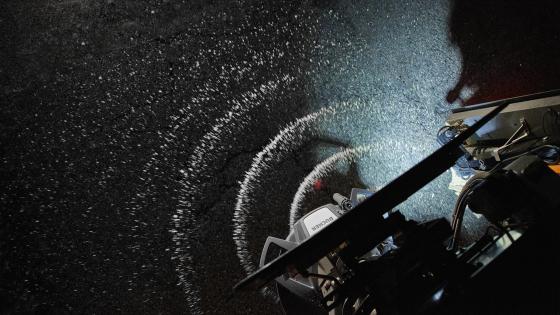
Surface stabilisation
One product helping to keep runways functioning year-round is EK35, a synthetic fluid and binder system that can be applied to gravel runways to strengthen and preserve them. Developed in the laboratory of Ohio-based Midwest Industrial Supply, EK35 allows airports to function during the most challenging conditions, performing in extreme temperatures and reducing the risk of damage to aircraft from loose aggregate. And it is well-suited to the wintry conditions many airports face. EK35’s ability to withstand multiple freeze and thaw cycles was demonstrated by a study led by researchers at the Norwegian University of Science and Technology, who concluded that it had a “significant stabilisation effect… both before and after exposure to the freezing-thawing actions”. Midwest, which has a production site in Spain and ships to customers across Europe, Asia and Africa as well as its home market in the US, claims that using EK35 to preserve gravel runways in cold regions can lead to a decrease in runway lifecycle costs of 70% and annual cost savings of up to $40,000. “When installed, EK35 creates a bound runway surface that results in improved performance, longevity, safety and stabilisation,” Midwest said. “An EK35-stabilised runway provides consistent accessibility year-round by eliminating seasonal soft spots, harmful moisture infiltration and freeze/thaw damage. This is critical to northern regions that are constantly combatting the effects of climate change and experiencing fewer ‘frozen’ months and more summer months.” The resin binder uses renewable resources.
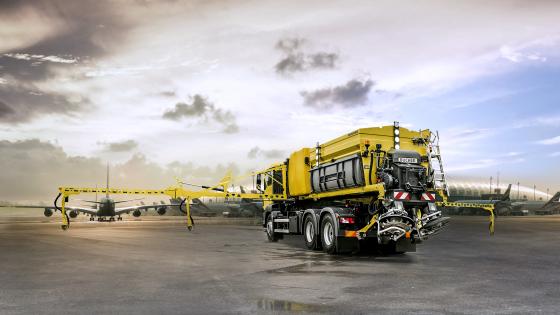
Chemical spraying to keep runways free of snow and ice is a costly process
Damage control
There have been many improvements in runway repair materials in recent years. For smaller pavement repairs, Calgary uses hot patch options that now come premixed and ready for immediate application. There is also a cold mix option available for quick winter pothole fixes, and for concrete repairs the airport employs Delpatch Elastomeric Concrete, a two-part epoxy treatment which Craig says is “extremely reliable”. However, no solution is perfect. The maintenance GM says the repair options available to his team are “extremely expensive” and that “more common adverse weather patterns” linked to climate change suggest the airport will need to use them with increasing frequency.
Regional airports must follow many of the same procedures as the large hubs, just with a smaller runway maintenance footprint. However, the extent to which they must adhere to the same regulator- or government-mandated requirements can differ. In Canada, regulations become more or less stringent based on the types of aircraft an airport can receive. As such, smaller airports with shorter runways are not required to ensure the same level of heightened runway maintenance needed to accept large aircraft, such as the Boeing Dreamliner 787 or 777, that a Tier 1 airport such as Calgary International Airport – which boasts Canada’s longest parallel runway, at 14,000ft – would be required to maintain.
We have multiple ways of performing runway maintenance without disrupting operations
Just as extreme heat can cause a runway to change due to molecular expansion and contraction, causing surfaces to melt and create low spots, extreme cold can cause damage to airport infrastructure. Ice and adverse cold weather can lead to runway surfaces cracking and this, in turn, leads to water penetration, which can eventually worsen pavement degradation and condition. In this instance, maintenance is required to protect the integrity of a runway by resealing surfaces and filling holes in uneven surfaces using asphalt.
Counting the costs
Allowing time for clearance inevitably impacts airline schedules and leads to delays as airfield operations are disrupted and turnaround times lengthened. And the process of snow removal is expensive. Snowploughs cost hundreds of thousands of pounds, and the chemicals used for de- or anti-icing amount to thousands of pounds per application. Swiss company Bucher Municipal has developed a range of machines for winter airport maintenance, with long folding arms enabling the entire runway to be cleared in a single sweep. The manufacturer also offers multi-functional machines that feature several tools on a single vehicle,to reduce operating labour costs.
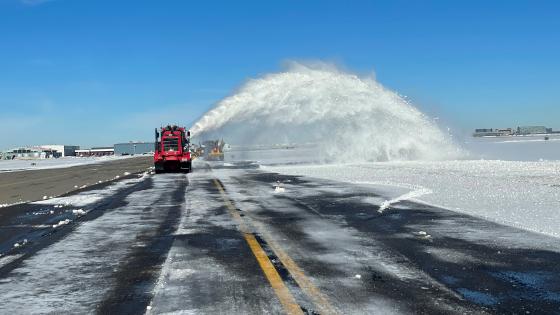
Playbooks developed annually in collaboration with NAV CANADA guide Calgary International through various winter weather scenarios
Temperature sensors are an important part of an airport’s winter toolkit, allowing operators to predict weather conditions hours in advance. Boschung, a family-owned business, offers anIce Early Warning System for airports. The equipment relies on meteorological sensors and pavement sensors to monitor for hazardous conditions including ice formation and freezing fog. Through Boschung’s runway management platform bVision, alarms can be triggered for specific locations within an airfield where ice is detected. Germany’s Lufft offers its own Intelligent Active Road Sensor that can be flush-mounted into a runway surface. Neither system is affected by the de- or anti-icing chemicals used for departing aircraft.
Lufft also markets its MARWIS – Mobile Sensor for Runway Condition Assessment – system, which supports the creation of runway condition reports and SNOWTAMs as a means of keeping runways safe with minimal effort. Lufft says the technology is not just about improving safety, it can also save airport operators money. The company states that the complete treatment of a typical commercial airport with de-icing fluids can cost hundreds of thousands of pounds, so pinpointing the areas that need this can result in big time and cost savings, ensuring the manpower and materials are in place when required. MARWIS was put through its paces at Amsterdam Schiphol Airport to predict when wing ice was likely to form, as well as at airports around Italy.
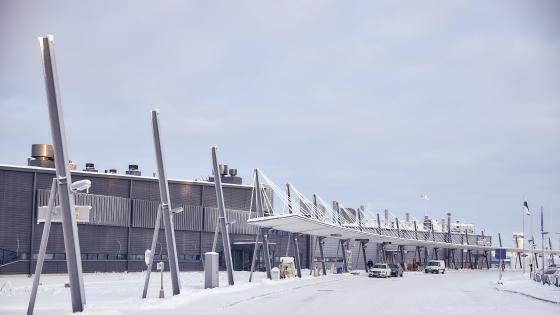
As Santa’s home airport, it is especially important that the runway at Rovaniemi stays open throughout the winter months
Temperature sensors are an important part of an airport’s winter toolkit, allowing operators to predict weather conditions hours in advance. Boschung, a family-owned business, offers anIce Early Warning System for airports. The equipment relies on meteorological sensors and pavement sensors to monitor for hazardous conditions including ice formation and freezing fog. Through Boschung’s runway management platform bVision, alarms can be triggered for specific locations within an airfield where ice is detected. Germany’s Lufft offers its own Intelligent Active Road Sensor that can be flush-mounted into a runway surface. Neither system is affected by the de- or anti-icing chemicals used for departing aircraft.
Lufft also markets its MARWIS – Mobile Sensor for Runway Condition Assessment – system, which supports the creation of runway condition reports and SNOWTAMs as a means of keeping runways safe with minimal effort. Lufft says the technology is not just about improving safety, it can also save airport operators money. The company states that the complete treatment of a typical commercial airport with de-icing fluids can cost hundreds of thousands of pounds, so pinpointing the areas that need this can result in big time and cost savings, ensuring the manpower and materials are in place when required. MARWIS was put through its paces at Amsterdam Schiphol Airport to predict when wing ice was likely to form, as well as at airports around Italy.
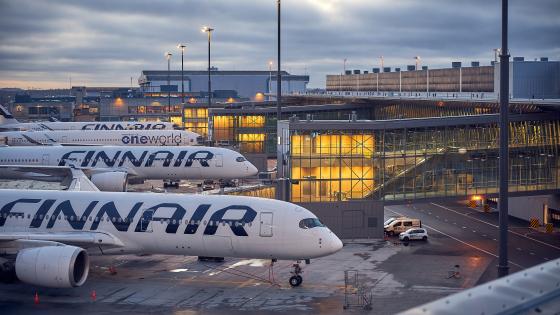
Airport operator Finavia’s snow patrol can clear Helsinki’s runways of snow in just 11 minutes
Rota Fabio, mechanical plant maintenance manager at Milan Bergamo Airport, said: “The MARWIS solution from Lufft is a very useful tool to get all necessary runway weather data in real time – for example the thickness of the contaminant, the contaminant type and the surface temperature.” The technology comes into its own in this environment since wing temperature can change relatively quickly, by up to 3°C within 20 minutes, and ice formation is impacted by other factors such as the presence of fuel from a previous flight. Thinking outside the box
Other innovations have attempted to tackle the problem of snow and ice head-on. These have ranged from water-repellent coatings to heated hydronic pavement systems. One potentially gamechanging system is the ICAX Solar Runway, which clears ice from runways, taxiways and aircraft parking stands using underground heating, removing the need for expensive snowploughing or chemical spraying. The equipment uses interseasonal heat transfer, a process that channels warmth from the sun down to the ground during the warmer months and back to buildings in winter. Heat captured by these solar runways – those with a network of fluid-filled pipes embedded beneath the surface – is held in ThermalBanks, a long-term heat storage device, and used in the winter to melt ice and snow as it forms.
Alternatively, materials such as graphite and carbon fibre can be used to create self-heating electrically conductive concrete (ECON) surfaces. This has been trialled at Des Moines International Airport, where Iowa State's Programme for Sustainable Pavement Engineering and Research installed two test slabs into the apron.
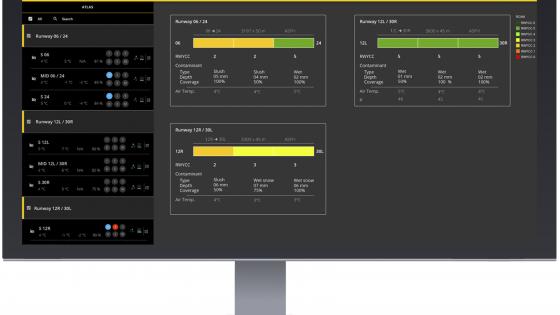
Boschung’s runway management platform bVision can trigger alarms for places on the airfield where ice is detected
The slabs of electrically conductive concrete consist of 1% carbon fibre and a mix of cement, sand and rocks. The carbon fibre allows the concrete to conduct electricity, and the heat is generated because of the resistance tothe moving electrons.Santa’s home airport
In Lapland, Finland’s northernmost region, snow covers the ground for up to 200 days a year, but the airports that must remain open through the coldest months from November to February are well equipped. Rovaniemi, which sits in the Arctic Circle and is the capital of Lapland, is especially busy over the winter period. As the official airport of Santa Claus, the facility must cope with an increase in air traffic just as the weather worsens. However, through a combination of technology, training and careful preparation, Lapland’s airports can withstand whatever an Arctic winter throws at them.
On a global scale, Finnish snow-how truly is second to none
Veli-Pekka Pitkänen, Finavia’s director for Northern Finland, which includes the five airports within the Lapland region, said maintenance and air traffic control staff must “keep a constant eye on weather forecasts” during the winter months: “All our runways are equipped with high-tech sensors that monitor tiny changes in the tarmac temperature 24/7. We are particularly interested in temperature changes around 0°C, as this is the trickiest temperature from an air traffic safety point of view.
“On a global scale, Finnish snow-how truly is second to none. Even though other countries with hard winters, like Canada and the United States, have much longer traditions in air traffic than Finland does, we regularly host industry experts keen to learn winter maintenance skills from us.”
Playing it safe
Despite the progress made developing new materials and machinery, the risk of a safety incident or accident remains. Recent examples include Spirit Airlines Flight 696, an Airbus A320Neo, which skidded off an icy taxiway at Baltimore/Washington International Airport in December 2020. Then there was China Airlines Cargo Flight CI5240, a Boeing 747-400F, which hit a baggage cart while taxiing in snow in January 2022, and a FedEx Express Boeing 767-3S2FER, Flight 872, which slid off an icy taxiway at Manchester-Boston Regional Airport (MHT) in the same month.
One of the principal hazards for aircraft operating to or from airports in wintry conditions is a lack of friction caused by surface ice, which affects brake efficiency and stopping distances. There is also a risk of corrosion linked to the use of de-icers. Consideration must be given to the interaction between aircraft and runway de-icing fluids, with mixing of the two potentially leading to the formation of gel residues. As salt is corrosive to aircraft, airports tend to use aviation-grade sand, liquid potassium acetate or sodium formate to treat the runways during precipitation events.
When the snow arrives, it must be mechanically removed using specialist ground equipment. These come in the shape of snowploughs, blowers and slings and brush machines. Friction tester vehicles and de-icing trucks are also called on to treat surfaces. Although airports try to carry this work out in advance or during quieter periods, safety dictates that snow and ice clearance is done regardless of traffic. The International Civil Aviation Organization brought in a new Global Reporting Format (GRF) for runway surface conditions in November 2021 to address this problem and reduce the risk of runway excursions by standardising the assessment and reporting of runway surface conditions, regardless of an airport's geographical location. Finavia's technical director, Henri Hansson, has described the new GRF as being “the most significant change in 50 years” in terms of runway winter maintenance.
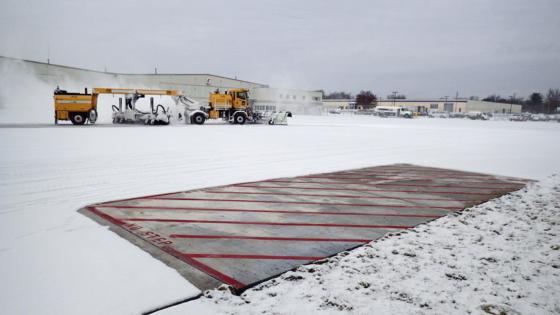
Heated test slabs installed by Iowa State engineers at Des Moines International Airport
Year-round operations
Winter brings a unique set of challenges for airports, but ensuring runways can remain open is a year-round operation. In Northern Finland, snow is expected to fall from October to May, and preparations for the following season must begin at the end of the previous, including scheduled maintenance of winter machinery alongside recruitment and training of staff. Countries used to experiencing regular snow and ice tend to be better prepared than most, but that does not mean winter conditions are without their hazards, even for the Finnish airport authorities. The capital Helsinki’s international airport has been forced to cancel or delay dozens of flights over several recent winters due to heavy snowfalls triggering low visibility procedures and slowing down the loading, unloading and de- and anti-icing of parked aircraft. This is despite Finavia’s snow patrol being capable of clearing Helsinki’s runways in just 11 minutes.
“Here in the Nordic countries, we are used to snowy and icy winters. However, snow-how is the outcome of years of professional development, training, cooperation and determination,” says Pyry Pennanen, head of airfield maintenance at Helsinki. “It is important that air traffic control (ATC)and maintenance are aware of each other’s activities at all times. Sweeping patterns are like maps of the precise movements of the snowploughs. They allow ATC to know up to 75 minutes in advance where the vehicles are at any given time. The ATC personnel plan traffic accordingly and make sure maintenance can work in peace. It is like a carefully rehearsed dance routine. Weather forecasting has developed and machinery is larger and more efficient. Nevertheless, the work is as tough and mechanical as ever."
